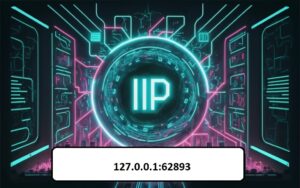127.0.0.1:62893: A Deep Dive into Localhost and Port Usage
In the realm of networking and web development, the IP address 127.0.0.1 holds a special significance. Often referred to as “localhost,” this address is a loopback address that allows a computer to communicate with itself. When combined with a port number, such as 62893, it opens up a world of possibilities for developers and network administrators. In this blog post, we will explore the meaning of 127.0.0.1:62893, its applications, and how it plays a crucial role in web development and networking.
What is 127.0.0.1:62893?
The IP address 127.0.0.1:62893 is the standard loopback address in IPv4 networking. It is used by a computer to refer to itself, allowing for internal communication without the need for an external network. This is particularly useful for testing and development purposes. When a user accesses 127.0.0.1, they are essentially telling their computer to connect to itself.
Why Use Localhost?
Using localhost has several advantages:
- Testing Environment: Developers can run and test applications locally without affecting live servers.
- Speed: Communication with localhost is faster since it doesn’t involve external networks.
- Security: Testing on localhost reduces the risk of exposing applications to the internet.
Understanding Port Numbers
In networking, a port number is a numerical label that identifies a specific process or service on a device. Each port serves as a communication endpoint for the applications running on a computer. The combination of an IP address and a port number creates a unique identifier for a service running on that machine.
Common Port Numbers
- Port 80: Used for HTTP traffic.
- Port 443: Used for HTTPS traffic.
- Port 22: Used for SSH (Secure Shell).
The port number 62893, as seen in 127.0.0.1:62893, is a dynamic or ephemeral port, which means it is typically assigned temporarily for a specific session or application.
The Significance of 127.0.0.1:62893
When you see 127.0.0.1:62893, it indicates that a service is running on your local machine, listening for incoming connections on port 62893. This could be any number of applications, such as:
- Web Servers: Local development servers like Apache, Nginx, or Node.js.
- Database Servers: Instances of databases like MySQL or MongoDB.
- Application Services: Custom applications that require a specific port for communication.
Example Use Cases
- Web Development: A developer might run a local web server on port
62893to test a new website or application before deploying it to a live server. By accessinghttp://127.0.0.1:62893, they can view their work in a browser. - API Testing: When developing APIs, developers often use tools like Postman to send requests to
127.0.0.1:62893, allowing them to test endpoints without needing a remote server. - Database Management: A local instance of a database might be configured to listen on port
62893, enabling applications to connect and perform CRUD (Create, Read, Update, Delete) operations.
How to Check What’s Running on 127.0.0.1:62893

If you want to find out what service is running on 127.0.0.1:62893, you can use various tools and commands depending on your operating system.
On Windows
- Open Command Prompt.
- Use the command:
bash
netstat -ano | findstr :62893
- This will show you the process ID (PID) of the service using that port.
On macOS/Linux
- Open Terminal.
- Use the command:
bash
lsof -i :62893
- This will list the application and its PID.
Security Considerations
While using 127.0.0.1 is generally safe, there are some security considerations to keep in mind:
- Firewall Settings: Ensure that your firewall is configured to block unwanted incoming connections to your localhost ports.
- Service Exposure: Be cautious about running services that could inadvertently expose sensitive data or functionality to the internet.
FAQs specifically for the blog post about 127.0.0.1:62893
FAQ 1: What does 127.0.0.1 mean?
Answer: 127.0.0.1 is the loopback IP address, also known as “localhost.” It allows a computer to communicate with itself, enabling developers to test applications locally without needing an external network.
FAQ 2: What is the significance of the port number 62893?
Answer: The port number 62893 is a dynamic or ephemeral port used by applications to listen for incoming connections. It indicates that a specific service is running on your local machine, accessible via 127.0.0.1:62893.
FAQ 3: How can I check what service is running on 127.0.0.1:62893?
Answer: You can check what service is running on that port by using commands like netstat -ano | findstr :62893 on Windows or lsof -i :62893 on macOS/Linux. These commands will show you the process ID (PID) of the service using that port.
FAQ 4: Why should I use localhost for development?
Answer: Using localhost for development provides a safe and efficient environment to test applications without affecting live servers. It allows for faster communication and reduces security risks by keeping development work off the internet.
FAQ 5: What are some common applications that might use 127.0.0.1:62893?
Answer: Common applications that might use 127.0.0.1:62893 include local web servers (like Apache or Node.js), database servers (like MySQL or MongoDB), and custom application services that require a specific port for communication.
Conclusion
The address 127.0.0.1:62893 represents a powerful tool in the arsenal of developers and network administrators. Understanding how to utilize localhost and port numbers effectively can streamline development processes, enhance testing capabilities, and improve overall productivity. Whether you are developing web applications, testing APIs, or managing databases, knowing how to work with 127.0.0.1 and its associated ports is essential.By leveraging the capabilities of localhost, you can create a secure and efficient environment for developing and testing your applications. So the next time you see 127.0.0.1:62893, remember the potential it holds for your projects, and make the most of this invaluable resource!

Post Comment